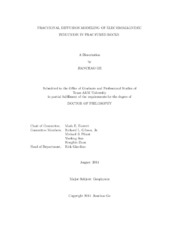| dc.description.abstract | The controlled-source electromagnetic (CSEM) technique is well-established for non-invasive geophysical survey. Due to the strong attenuation of earth materials to electromagnetic signals, the effective depth of most CSEM surveys is restricted to 1-2 km, a zone where pores and fractures over various length scales are highly complicated. Spatial confinement of fluid or electric charge transport by the fractal geometry gives rise to interesting dynamic processes within the pore space and fractures, such as anomalous diffusion.
Conventionally, CSEM data are interpreted in terms of a 1-D, 2-D or 3-D piecewise constant geological structure with uniform conductivity and thickness of each cell. A very fine grid, and hence a lot of computation time, are needed to build and evaluate a model that can explain the Earths actual 3D CSEM response. Good accuracy may not be captured, using the conventional approach, in the presence of multi-scale hierarchical geoelectrical structure. Alternatively, the CSEM response of such structures are easily evaluated if the physics of anomalous diffusion of electromagnetic
eddy currents is recognized and cast, for example, in terms of a continuous time random walk. Such a re-formulation leads to a generalization of Maxwell equations containing a fractional order time derivative. The fractional order of the derivative is equivalent to a roughening of the geological medium, introducing multi-scale variations of fractures and heterogeneities in a compact manner. This theory renders CSEM modeling and inversion much more efficient, as only a few model parameters are now required to be fit. However the EM fractional diffusion theory is far from perfect, e.g. the correlation between the roughness of a fracture model with its fracture properties. In this research, I use numerical modeling tool to answer this question and explore if classical piece-wise constant conductivity model can generate a fractional type response.
In this thesis, I will review the fundamental theory of traditional CSEM survey technique and the continuous time random walk approach, and review the derivation of the generalized Maxwell equation. More importantly, I propose the finite difference method to discrete the generalized Maxwell equation in 2D and 3D. I explore a classical fractured model response created from the von Karman random media approach. I will show that the von Karman fractured model generates a classical type response which is inconsistent with the fractional diffusion response. It is difficult
to generate a classical model numerically that is comparable with the rough natural model. | en |


